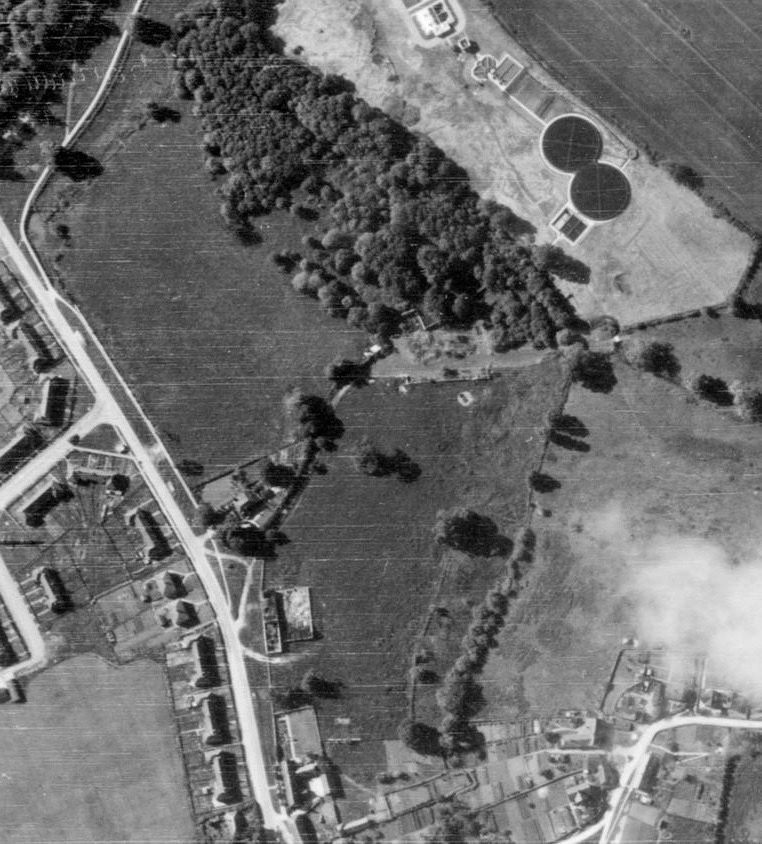The Willington Map at the front of this book on the ‘Key Page’ shows, by comparison to the rest of the village, what appears to be a large private estate at its southern end (where Barrington Road and Shute Avenue now stand). It clearly depicts a huge building surrounded on its southern side by ornamental gardens and grounds.
Although it is not certain when the first house was built here, we do know that by the 18th century it was the grandest house in the village. What is also clear is that the 8 hearths that Richard Franklyn was paying for in tax, could only have belonged to a house of considerable size. The Georgian design of this house would suggest that it was erected in the early part of the 18th century, but Richard Franklyn was much earlier in 1663. From this it would be reasonable to assume that the house Richard Franklyn occupied was taken down to be replaced by this house.
It was the remains of this house, known as Watchfield House, that helped spark my interest in the history of the village. I can remember clambering over the walls just on the edge of the woods and using them as cover in various games me and my pals would play. I can remember asking some of the local elders just what the walls were once part of and was always told, ‘just old barns.’ That answer satisfied me at the time but as I matured and my knowledge increased I realised this could not be the case. Picture 20 below is part of a Black and White photo taken by the RAF in 1946. The walls that formed part of the gardens of the house that I played on, and also the spot where the house once stood, can clearly be seen.

Picture 20.
Courtesy of English Heritage (NMR) RAF photography.
Ref: RAF/106G/UK/1561. Frame 3353. 7 June, 1946.
Watchfield House was located in the centre by the trees. At the top left, just in view, is Maiden’s Well. This was a pond by the side of the road, naturally fed by a stream which still flows from it even though it is now covered over. It was undoubtedly used anciently as a watering point for drove animals whilst passing along the main road or going in and out of the village.


The road leading to the house from The Street (Now High Street) was called Blagrave’s Lane. If you compare this to the Willington Map on the Key Page at the beginning of this book, the correlation between the two is remarkable. The formal entrance to the House can also be seen, and until recently the gate pillars still in place, but now, sadly, destroyed by builders. (Pictures 21 & 22 above)
Picture 23 is a copy of a plan of Watchfield House dated 1815 which was found in the back of one of the water colours below.

Picture 24 (above). Watchfield House, Circa 1815 approx, as seen by the artist from the High Street. Note the tower of Shrivenham Church just protruding above the wall. Courtesy of David Ferrand

Picture 25 (above). Watchfield House, Circa 1815 approx, as seen by the artist from the vicinity of Northford Bridge on the road to Shrivenham. Courtesy of David Ferrand

Picture 26 (above). Watchfield House location. Must have been an impressive sight from the High Street in the 18th century
Pictures 24 and 25 are copies of original water colour paintings, probably from the same date. These came to light through David Ferrand of Clifton, near Ashbourne in Derbyshire, who had been in contact with Mrs Arline Fisher of Bourton End near Shrivenham, concerning family geneology. One of his relatives, Richard Smith, had lived in the house in the early part of the 19th century and is buried at Shrivenham. It’s an impressive Georgian House and must have looked very grand to passers-by on the High Street. The site now lies under the modern houses at the top end of Barrington Road (Picture 26).
So to whom did the house belong? The most influential family residing in Watchfield from the 16th to the 18th centuries was the Blagraves. In the early period the Watchfield family were not related to the Blagraves at Calcot, Reading. But the union of John Blagrave of Watchfield (b.1750) and Frances Blagrave of Calcot (b.1761) when they married in 1779, brought the two families together. It is possible to confirm circumstantially from various sources that the Blagraves did indeed own the property at certain points in time, but it’s frustratingly difficult to find conclusive documentary proof. The Willington map of 1758 labels the estate as No 3 and the reference box notes that it belongs to Mrs Blagrove. (The difference in spelling of names is common throughout the centuries). Another conclusive source is from a mortgage document dated 7 June, 1847 (BRO D/EX310/35) whereby Anthony Blagrave and Colonel John Blagrave make an assignment to borrow the sum of £5000 against property in Watchfield described as; ‘All that Mansion House with the buildings stables gardens plantations and pleasure ground thereto belonging containing by measure 3acres 2roods 8perches. And also that close of meadow or pasture ground called the Great Close containing by statute measure 4a 3r 32p. And also that other close formerly two closes and now called the Little Orchard and Pew Acre containing 2a 3r 36p. All which said Mansion House closes afterwards untenanted are now in the occupation of the said John Blagrave hereto.’ And part of another paragraph within the same document includes; ‘And also all that barn, granary, cart house and cow house situate at Watchfield and nearly adjoining unto the Mansion House, and buildings formerly in the occupation of John Blagrave deceased afterwards Charles Blagrave, afterwards of the said William Mairess.'
The Blagrave name features very frequently in documents throughout the 16th to the early 19th centuries. That they were a wealthy family is made obvious by the size and quality of the memorial tablets that lie over their crypt within Shrivenham Church. From these tablets and from the newspaper archive it is possible to deduce that upon the death of Ann Blagrave in 1784, aged 95, the house was put up for rent. An advertisement in the Reading Mercury dated 2nd October 1786, offered the house to rent for 40 guineas per annum with immediate possession. At the moment it’s not known who the first tenants were. Another advertisement in the Oxford Journal dated 29th September 1798, provides the information that the house was to be let furnished or unfurnished, and that the occupier at that time was Charles Blagrave. We get the name of the next occupier from another advertisement in the same newspaper dated 19th July 1800, when the outgoing tenant is Mr Rowley Lascelles Esq. There is also a good description of the house and grounds.
The next tenant is something of an enigma. The Oxford Journal of 3rd December 1808 advertised the sale of household furniture and other valuable effects, the property of the late Hon. Capt. Charles Herbert, deceased, at Watchfield House. The advert describes in some detail the items to be sold. It also stated that a collection of fine old wines and other liquors would be sold at a separate auction. Charles Herbert was a naval officer, born in 1774, the second son of Henry Herbert, the first Earl of Carnarvon. He entered the navy at an early age in 1790 and rose rapidly through the ranks to captain within five years. The nearest he can be placed to Watchfield was when he married the Hon Bridget Augusta Byng in July 1800 at Salisbury. He was elected as an MP as the member for Wilton, Salisbury, in 1806. At the moment we have no idea how he came to be residing in Watchfield House, and Wikipedia states that he died when his boat overturned in Gijon harbour.
The Oxford University & City Herald dated 13th May 1809, reported a wedding between William Whitworth Esq of Watchfield House and Miss Rebecca Court, the youngest daughter of John Court of Oxford. The ceremony took place at St Mary’s Church, Oxford. Two of their children, William and Mary, were subsequently baptised at St Andrews Church, Shrivenham as there was no church at Watchfield at that time, and wouldn’t be until 1857.
A very brief clue from the Morning Post dated 29th October 1813, mentions under its heading, ‘fashionable changes,’ that Miss Mildmay visited the Hon Henry St John of Watchfield House near Faringdon in Berkshire. It would appear that he followed the Whitworth family. He was the youngest son of John St John, the 2nd Viscount St John. In his early life he was a British Army officer. He became an MP and was elected the member for Wootton Bassett in 1761. Like Captain Herbert above, we have not discovered yet the circumstances of how he came to reside in Watchfield House.
The letters of George Merryweather, (SHS Letter No 44, dated 17/10/1816) confirm that John Dixon and his wife Ann moved into the house in October 1816. Staying with them was Ann’s father Richard Smith. A floor memorial tablet in St Andrews church, Shrivenham, gives the information that Richard was an eminent Merchant from Boston, USA and he had returned to retire with his daughter in Watchfield House. He was a wealthy man and provided the funds for teaching the poor children of the village. He died in February 1818. A direct descendant of Richard Smith, David Ferrand, lives in Derbyshire and contact was made with him through a mutual friend. He possessed two watercolour paintings showing Watchfield House from two different perspectives as shown here. Tucked in the back of the frame of one of the paintings was a plan of the house. It is thought very likely that Ann Dixon was the artist.
After the Dixons came William Hallet. An advertisement in the Salisbury & Winchester Journal dated 2nd December 1822, provided the information that he had previously lived at Denford House near Hungerford, Berks. The amount of goods that were for sale was huge and this advert listed them in detail. It also added that the reason for the sale was that he was, ‘removing to Watchfield House.’ William Hallet was the Chairman of the Wilts & Berks Canal Company. The canal ran past Shrivenham on its south side and at that time was doing well. He left the house in 1825 when an advertisement in the Devizes & Wilts Gazette dated 1st July 1825 noted that his collection of wines and spirits were to be sold by auction at the Barrington Arms, Shrivenham in August. His household furniture and effects were also sold by auction in October of that year.
At this point in the houses’ history, it may be as well to point out that it was still in the ownership of the Blagrave family. We know that Charles Blagrave was still local as he died in June 1828, and his Will noted that he was, ‘late of Watchfield.’ (PROB 11/1741/395). The owner of the property, John Blagrave had moved out of the village back in 1779. He also died in 1828 and in his Will he noted that he had a diverse number of estates in Berkshire. (PROB 11/1746/458). He also added that some of those estates, ‘stand charged with sums of money on mortgage.’ The Blagrave Estate had been in financial difficulty for some time. Ten years earlier, George Merryweather, Steward of the Beckett Estate, had made numerous mentions in his letters to Lord Barrington, concerning the high level of debt that the Blagraves were in.
In 1826 the house appeared in the Oxford Journal of 13th May, once more to let. However, this time the wording stated, ‘To be Let, for 12 years from Michaelmas last.’ This is likely brought about from the previous history of lettings for short periods. But somehow around this time, the lease of the house appears to be in the hands of Lord Radnor at Coleshill.
On 4th June 1828, Solicitors R.C. Crowdy of Faringdon wrote to Lord Radnor enclosing a letter from a former tenant Mr Rowley Lascelles, who wrote, ‘Sir, upon consideration and maturely weighing the Rent Taxes and expenses attending the furnishing of Watchfield (House), it would not answer my purpose to make you an offer for Watchfield House and the 22 acres of land to a greater extent than one hundred pounds per annum and in this offer I must be exonerated from repairs which from the appearance of the house I should not like to be responsible for.’ (BCA. D/Epb C2). His offer was not accepted as Crowdy laments in a letter to Lord Radnor on 11 June, ‘I begin now to despair of obtaining a Tenant and you will I fear have to hold the place on until Michaelmas 1830, when you can then put an end to the term, unless a Surrender of the Lease would in the meantime be accepted.’
But on 28 March, 1829 Mr Crowdy has good news for Lord Radnor, ‘My Lord, I have at length the satisfaction of informing your Lordship that I have this day partly agreed to let Watchfield House, Land and Premises to Mr Berens and Mr Dawson on behalf, I believe, of Dowager Lady Barrington, at the same rent and on the same terms at which it is now held of Mr. Blagrave. ‘
The circumstances that brought this about were that on the 5th March 1829, George, Lord Viscount Barrington (5th) had died suddenly whilst in Rome. His eldest son William Keppel acceded to the title, becoming the 6th Viscount, and was very keen to get on and build the new Beckett House. As this meant that the old house would be totally demolished, the Viscount and his family would have to find other accommodation. His mother, Dowager, Elizabeth Barrington was due to move into the Dower House, at Shrivenham, (now Shrivenham House). However, she graciously allowed her son and his family to occupy it, whilst she and her servants rented Watchfield House. The men who organised the rental were Edward Berens, the Vicar of Shrivenham and Joseph Dawson, Steward of the Beckett Estate.
Dowager Lady Elizabeth Barrington vacated Watchfield House in 1834 and moved back to Shrivenham. Her son William, the 6th Viscount and his family moved into the completed part of the newly built Beckett House. The next documentary evidence we have is an advertisement in the Berkshire Chronicle dated 16th June 1838 and Watchfield House is to be let again with immediate possession, from year to year or for a term. The agents had also changed from Crowdy to Phillips & Westbury.
The Census of 1841 shows that the house was occupied by John Tucker, a 25 year old Civil Engineer, (highly likely to have been employed on the new Great Western Railway project) and by Charles & Elizabeth Bush and Benjamin & Jane Turner who were locals employed as servants. In 1847 the whole Blagrave landholding in Watchfield, including the house, was put up for sale. The Oxford Chronicle dated 25th September lists that Colonel Blagrave is selling everything, Watchfield House, Farm House with cottages and 388 acres of land, and other lands and buildings. Brochures were printed, but alas non seemed to have survived and there is no record of who bought what.
The census of 1851 shows no listing at all for the house and we can only deduce that it was unoccupied. When the foundation stone was laid for the new church of St Thomas at Watchfield, the Reading Mercury of 23rd May 1857 sent a reporter to note the proceedings. Included in the list of those attending was Mr G. H. Atkins, Esq of Watchfield House. Another newspaper article informs that he’s called George Martin Atkins. The census of 1861 shows that George Atkins still occupied the house. He is described as 46 years of age and is a landed proprietor, so it’s likely that he was the owner of the property. Also in the house is James Partridge a Gardner and Bailiff, and Mary his wife.
The house does not appear on the 1871 census with its own heading, but a wedding announcement in the North Wilts Herald dated 14th May 1870, provides the information that it is Olivia, the daughter of the Rev T.O Rogers of Watchfield House, who is getting married. The census record shows that he is Thomas Oliver and his wife Mary Amelia living there along with Joseph 19, and a servant Ursula. By this time, the end is near for the house and in the Swindon Advertiser newspaper dated Monday 21st December, 1874, the following article appeared, ‘Watchfield House, which has been in a dilapidated condition for some years past, was burnt down on Tuesday last (15thDec). It had been doomed for some time and workmen had been employed at various times taking down marble chimney pieces and other things worth saving. It seems these workmen on the Monday last, made a fire on the ground in one of the rooms, which was left burning at night and which was the cause of the conflagration. The Faringdon fire engine was sent for and every precaution taken to protect the surrounding property.'
We can account for the ownership of Watchfield House from the mid 18th century until its demise in 1874. However, earlier is more of a problem. The biggest question yet to answer is, ‘who built it and exactly when?'